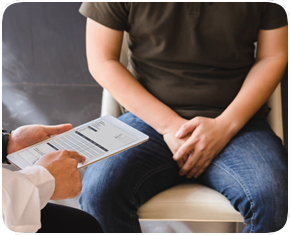< Home | Conditions and Treatments | What is hypogonadism or «low testosterone»?

It is the decrease or total absence of testosterone secretion, which is a hormone produced by the testicles, which fulfills multiple functions in the human body, from helping the development of male physical and sexual characteristics, to maintaining natural functions such as impulse sexual performance, semen production, and the bone and muscle health of the individual.
In the United States, approximately 4 to 5 million men suffer from this disease, of which only 5% receive adequate treatment. Age plays a very important role since as men get older, testosterone levels decrease.
Symptoms vary depending on the severity of the deficiency, as well as the physical condition of the patient. These symptoms can include:
There are two types of hypogonadism, primary and secondary. Both have different causes.
o Its causes include infectious diseases, cancer treatments, a history of inflammation from mumps (“mumps”), trauma to the testicles, and previous surgeries.
o Its causes include infectious diseases, tumors, and use of certain medications.
Obesity also plays an important role in this disease, as fat can transform testosterone into estrogen, which is a feminizing hormone.

Most studies have shown that improving testosterone levels increases libido and sexual function in men. In addition, recovering normal hormonal levels help normalize mood, reduce lack of energy, and increase muscle and bone mass.
The first recommended treatment is simple: improve diet, increase physical activity, lose weight (if you are overweight), and avoid alcohol and / or drug use.
In case of requiring hormone replacement, there are different methods such as testosterone gel, patches, intramuscular or subcutaneous injections, and subcutaneous beads (“pellets”).
Like all medical treatment, there are potential side effects and risks associated with hormone replacement. That is why it is highly recommended that this type of treatment be performed only by specialized professionals, in order to obtain excellent care.
If you think you have any symptoms of low testosterone (hypogonadism), we are here to help you discreetly and confidentially.
Contact us today to make an appointment


The goal of these procedures is to obtain a patent urinary canal and improve the flow of urine …

Symptoms vary depending on the type of incontinence. Usually the patient may experience …

Premature Ejaculation can be primary (better known as “for life”) or secondary (better known as acquired) …

© 2024 Puerto Rico SWC – All rights reserved